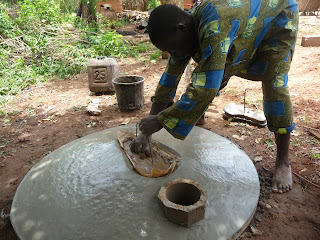Benin is a very religious nation. Christianity is the largest religion in the South (there are a lot of Catholics, in particular, in Lalo) and Islam is more prevalent in the North. However, the national and biggest religion of Benin is “Vodoun,” or Voodoo as we spell it. Voodoo is an animistic religion, but its beliefs and gods are usually mixed with other religions. That is to say that if a Beninese is Catholic, they also practice Voodoo as well.
Voodoo in Benin is not the violent religion of bloody-sacrifices and voodoo dolls that we think of, but instead it is about the power of nature and the natural forces in life. It permeates every aspect of life in Benin because they believe that spirits are everywhere and are an integral part of daily happenings in life. It is most easy to relate Voodoo beliefs to the Native Americans’ beliefs that there were spirits in every part of nature and they must be properly cared for, if they are going to care for you in return. For example, this rainy season there was not a lot of rain. The Beninese explained this by saying that the gods must not have been properly thanked after last year’s rainy season. In this case they would do a sacrifice for the gods- typically a chicken or a goat. That being said, this is not an everyday occurrence that we see here.
The Beninese also use voodoo to explain what happens in life that they can’t understand. For example, if a person suddenly dies, it is assumed that they must have done something bad and they were either cursed by someone or a god. Whereas we would contribute a death to a medical condition and then have an autopsy performed, the Beninese assume that they died for a reason. We have seen this on multiple occasions, including with one of Miranna’s students, Ivette, that died in November. It was explained to us (in a very matter of fact manner) that her sister had refused to get married because she wanted to stay in school, so Ivette helped her run away. Her father was upset with her and put “gris-gris” on her. Shortly thereafter Ivette developed a headache and then she died. This story was hard to digest because common sense tells us that people don’t just suddenly die of headaches. Maybe she had already been sick and it was a coincidence that she died when her dad was upset with her- or maybe the Beninese have some rhyme and reason to their beliefs.
“Gris-gris” is a ceremonial process where someone is either partaking in an effort to protect themselves from evil spirits or performing an act to bring harm to someone. An example of the latter is mentioned above. As an example of protecting themselves, people often make a special soap with which to wash themselves. We were privy to watching one of these soap making ceremonies- which was very interesting. The process was as follows: grounding up a lot of leaves, roots, and herbs that all have medicinal powers, mixing in some sodabi (the local alcohol), sacrificing a chicken on top of the soap, and then chanting in the local language. We were told that if you wash yourself with this soap at least once a month, then you are protected from all the evil spirits. We personally declined taking some home, we’re happy with Dove.

The Village Chief adding alcohol to the soap during the ceremony.
Another aspect of voodoo that plays an important role in life here is the strong belief in the afterlife. When someone dies they turn into a spirit- and this is one reason why funerals are such a big event (and why so much money is spent on them). Not only is it necessary to celebrate the life they lived, but it is necessary to welcome the rebirth of their spirit. The two types of “spirits” that we commonly see are pictured below. At some point, before, during or after a funeral service the spirits come out and dance and “speak” to the onlookers. These are really big events in Lalo which involve a lot of drumming, singing, and dancing. The spirits also “chase” the onlookers and it is forbidden that they touch you because you will then die- so you better run fast!

Zangbetos (don't they look like the characters in the book "Where the Wild Things Are"?)

Egunguns (While not the most friendly of fellows, their costumes are really bright and colorful!)
This is just an overview of beliefs here in Benin- as we have experienced them. Voodoo is a complicated and mysterious religion that we will not fully understand even after 2 years. It’s hard to explain the depths to which these beliefs affect everyday life. In addition, religion, whether voodoo or otherwise, has an enormous economic toll. The amount of money that is spent on special clothes, religious items, funerals, and offerings blows our mind. We have been to a few religious services and at each one they take offerings no less than five times throughout the mass. At the end of the service, they then announce how much money was raised for the church that day. However, when there are not too many other distractions in life in a small village, on what else are you going to spend your money and time?

Miranna with our neighbors after Inez, the youngest daughter in the family, was confirmed in the Catholic church. For a ceremony such as this, most everybody in the church will wear outfits made of matching cloth. We had been out of town before the big event, so we were not able to purchase religious fabric featuring the Saint Augustin. We were crushed!














































